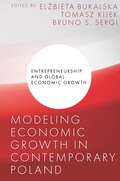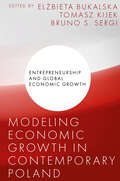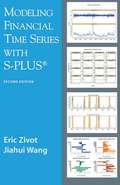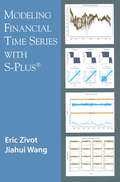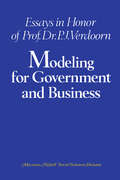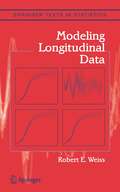- Table View
- List View
Modeling Economic Growth in Contemporary Greece (Entrepreneurship and Global Economic Growth)
by Vasileios Vlachos, Aristidis Bitzenis and Bruno S. SergiIn the aftermath of the devastating economic depression suffered for almost a decade, Modeling Economic Growth in Contemporary Greece assesses the conditions shaping the Greek economy's restart, discussing the effect of institutions on the business environment and highlighting the factors which are critical for achieving sustainable economic growth. The intrinsic properties of the Greek economic and business environment imply that there are country-specific factors responsible for the performance of the Greek economy, which is differentiated from its European counterparts. Despite being a member of the European Union since 1981 and one of the twelve first countries who adopted the euro, Greece has not been able to converge in crucial macroeconomic indicators with the early euro area Member States. The European stimulus package to support post COVID-19 recovery appears as a unique opportunity for Greece to develop a long-term vision and materialize reforms that will unlock the economy's true potential. This latest book in the Entrepreneurship and Global Economic Growth series is centred around the determinants of and obstacles to Greece’s sustainable economic growth, presenting the macroeconomic and external environment and the dynamics of Greek economy and focuses onto internal conditions shaped by country-specific characteristics affecting labor and product markets’ efficiency and the performance of institutions and production factors.
Modeling Economic Growth in Contemporary Hong Kong (Entrepreneurship and Global Economic Growth)
by Michael K. Fung Bruno S. SergiServing up fresh insights on Hong Kong's economic growth, this book investigates issues such as housing, immigration, monetary and financial systems, the business environment, and international trade and finance to provide a coherent and comprehensive overview of Hong Kong’s position in the global economy. Exploring these interrelated topics chapter-by-chapter, the authors cover contemporary macroeconomic topics such as government policies supporting structural changes of the Hong Kong economy challenges to the pillars of Hong Kong’s economic growth, factors determining the success and failure of emerging sectors, the impacts of the linked exchange rate system on the financial and monetary markets, the tightening integration between the Hong Kong and Mainland China economies, Hong Kong’s real estate market and its socio-economic impact, regional competition, and the operation and contribution of Mainland Chinese enterprises in Hong Kong. With broad application across several courses, this book is appealing reading to researchers in the fields of economic policy, economic growth, financial modelling, and more.
Modeling Economic Growth in Contemporary Hong Kong (Entrepreneurship and Global Economic Growth)
by Michael K. Fung, Bruno S. SergiServing up fresh insights on Hong Kong's economic growth, this book investigates issues such as housing, immigration, monetary and financial systems, the business environment, and international trade and finance to provide a coherent and comprehensive overview of Hong Kong’s position in the global economy. Exploring these interrelated topics chapter-by-chapter, the authors cover contemporary macroeconomic topics such as government policies supporting structural changes of the Hong Kong economy challenges to the pillars of Hong Kong’s economic growth, factors determining the success and failure of emerging sectors, the impacts of the linked exchange rate system on the financial and monetary markets, the tightening integration between the Hong Kong and Mainland China economies, Hong Kong’s real estate market and its socio-economic impact, regional competition, and the operation and contribution of Mainland Chinese enterprises in Hong Kong. With broad application across several courses, this book is appealing reading to researchers in the fields of economic policy, economic growth, financial modelling, and more.
Modeling Economic Growth in Contemporary Indonesia (Entrepreneurship and Global Economic Growth)
by Bruno S. Sergi, Dedhy SulistiawanThis new volume of the Entrepreneurship and Global Economic Growth series explores Indonesia's most recent business and economic developments. Modeling Economic Growth in Contemporary Indonesia has chapters covering topics such as SMEs, public companies, stock markets, government, or non-profit organizations to explain economic growth and factors. Modeling Economic Growth in Contemporary Indonesia chapters carefully addresses economic growth in contemporary Indonesia. Since the Asian monetary crisis in Indonesia has initiated reforms and its progress is substantial, becoming the largest economy in Southeast Asia and the world's 16th largest. Featuring empirical studies in management and organization along with market-based studies discussing the economic growth of contemporary Indonesia, chapters cover a broad range disciplines, including entrepreneurship, government support, family business, marketing strategy, stock market, poverty, and microfinance. Modeling Economic Growth in Contemporary Indonesia’s analysis touches on timely, interdisciplinary subjects effecting both big and small cities in Indonesia while also highlighting the role of education in improving entrepreneurship.
Modeling Economic Growth in Contemporary Indonesia (Entrepreneurship and Global Economic Growth)
by Bruno S. Sergi Dedhy SulistiawanThis new volume of the Entrepreneurship and Global Economic Growth series explores Indonesia's most recent business and economic developments. Modeling Economic Growth in Contemporary Indonesia has chapters covering topics such as SMEs, public companies, stock markets, government, or non-profit organizations to explain economic growth and factors. Modeling Economic Growth in Contemporary Indonesia chapters carefully addresses economic growth in contemporary Indonesia. Since the Asian monetary crisis in Indonesia has initiated reforms and its progress is substantial, becoming the largest economy in Southeast Asia and the world's 16th largest. Featuring empirical studies in management and organization along with market-based studies discussing the economic growth of contemporary Indonesia, chapters cover a broad range disciplines, including entrepreneurship, government support, family business, marketing strategy, stock market, poverty, and microfinance. Modeling Economic Growth in Contemporary Indonesia’s analysis touches on timely, interdisciplinary subjects effecting both big and small cities in Indonesia while also highlighting the role of education in improving entrepreneurship.
Modeling Economic Growth in Contemporary Malaysia (Entrepreneurship and Global Economic Growth)
by Mohd Fahmee Ab HamidIn the current global market, which is turbulent, volatile, and continuously changing, companies must consistently sustain and survive during turbulent times. Although Malaysia is paving a way to adapt to the advancement of technology, one of its biggest challenges is sourcing the knowledge, skills, and competencies that will supply solutions to transform Malaysia into high value competitor for industrial countries. The newest book in the Entrepreneurship and Global Economic Growth series, Modelling Economic Growth in Contemporary Malaysia considers the crucial changes to Malaysian economic areas and social well-being. Exploring issues from various perspectives including entrepreneurship, economic, financial, banking, marketing, and human resource, the chapters cover diverse industries such as IT, green technology, retailing, banking, tourism and hospitality, education, logistics, finance, banking, and many others. Acknowledging that Malaysian companies must embrace the notion that human capital is a crucial contributor to competitive advantage, this book brings forward consumers' behavioral issues from the marketing lens, offering a critical exploration of how money spending interacts with choices relating to desired products or services.
Modeling Economic Growth in Contemporary Malaysia (Entrepreneurship and Global Economic Growth)
by Bruno S. Sergi Abdul Rahman JaaffarIn the current global market, which is turbulent, volatile, and continuously changing, companies must consistently sustain and survive during turbulent times. Although Malaysia is paving a way to adapt to the advancement of technology, one of its biggest challenges is sourcing the knowledge, skills, and competencies that will supply solutions to transform Malaysia into high value competitor for industrial countries. The newest book in the Entrepreneurship and Global Economic Growth series, Modelling Economic Growth in Contemporary Malaysia considers the crucial changes to Malaysian economic areas and social well-being. Exploring issues from various perspectives including entrepreneurship, economic, financial, banking, marketing, and human resource, the chapters cover diverse industries such as IT, green technology, retailing, banking, tourism and hospitality, education, logistics, finance, banking, and many others. Acknowledging that Malaysian companies must embrace the notion that human capital is a crucial contributor to competitive advantage, this book brings forward consumers' behavioral issues from the marketing lens, offering a critical exploration of how money spending interacts with choices relating to desired products or services.
Modeling Economic Growth in Contemporary Poland (Entrepreneurship and Global Economic Growth)
by El 380 Bieta Bukalska Tomasz Kijek Bruno S. SergiOver the past 15 years, Poland has been one of the fastest-growing countries in the European Union. Trying to explain the sources of Poland’s economic success and decouple it from simple stylized facts on economic convergence anchored in the neoclassical growth models, the authors show how the Polish economy rapidly moved away from the communist economic system, which had ended up in an economic collapse, and moved towards unprecedented growth in income and the quality of life. Analyzing the transition and contemporary challenges of the Polish economy – including resilience to COVID and the Ukraine war, issues relating to Polish economic growth’s institutional and policy framework, and the prospects of economic growth in Poland from the micro, mezzo, and macro perspectives – Modeling Economic Growth in Contemporary Poland is suitable for practitioners and academics interested in discovering the foundations for Polish growth, exploring whether this growth will likely last in the future. Entrepreneurship and Global Economic Growth presents modern examinations of economic growth at national, regional, and global levels. Each book in this series discusses different dimensions of the changing economic and industrial contexts and examines in detail their impact on the nature of growth and development.
Modeling Economic Growth in Contemporary Poland (Entrepreneurship and Global Economic Growth)
by Elżbieta Bukalska, Tomasz Kijek, Bruno S. SergiOver the past 15 years, Poland has been one of the fastest-growing countries in the European Union. Trying to explain the sources of Poland’s economic success and decouple it from simple stylized facts on economic convergence anchored in the neoclassical growth models, the authors show how the Polish economy rapidly moved away from the communist economic system, which had ended up in an economic collapse, and moved towards unprecedented growth in income and the quality of life. Analyzing the transition and contemporary challenges of the Polish economy – including resilience to COVID and the Ukraine war, issues relating to Polish economic growth’s institutional and policy framework, and the prospects of economic growth in Poland from the micro, mezzo, and macro perspectives – Modeling Economic Growth in Contemporary Poland is suitable for practitioners and academics interested in discovering the foundations for Polish growth, exploring whether this growth will likely last in the future. Entrepreneurship and Global Economic Growth presents modern examinations of economic growth at national, regional, and global levels. Each book in this series discusses different dimensions of the changing economic and industrial contexts and examines in detail their impact on the nature of growth and development.
Modeling Economic Growth in Contemporary Russia
by Bruno S. SergiRussia is one of the world's largest growing economies. With this exciting new growth and development, there is a wealth of knowledge to be discovered from the strategies and models being used and created throughout Russia’s economy. Modeling Economic Growth in Contemporary Russia portrays and sets pieces of Russia's growth strategies to produce an extraordinary record of economic analysis. A leading expert in emerging markets, editor Bruno S. Sergi and a cast of experienced Russian academics offer a wealth of questions and critical examples on Russia that are delivered through a sound framework and provide unique knowledgeable support and interdisciplinary research about modeling a sound growth strategy for Russia. Through various chapters on financial development and economic growth, Sergi explores the fascinating landscape of Russia's economy, including chapters on green investment; education and inclusive development; sustainability; smart cities; international cooperation; and innovation-based growth. For anyone interested in international economics, or students of emerging economies and markets, this is a fundamental study of an area that has never before been studied in such depth.
Modeling Economic Growth in Contemporary Russia
by Bruno S. SergiRussia is one of the world's largest growing economies. With this exciting new growth and development, there is a wealth of knowledge to be discovered from the strategies and models being used and created throughout Russia’s economy. Modeling Economic Growth in Contemporary Russia portrays and sets pieces of Russia's growth strategies to produce an extraordinary record of economic analysis. A leading expert in emerging markets, editor Bruno S. Sergi and a cast of experienced Russian academics offer a wealth of questions and critical examples on Russia that are delivered through a sound framework and provide unique knowledgeable support and interdisciplinary research about modeling a sound growth strategy for Russia. Through various chapters on financial development and economic growth, Sergi explores the fascinating landscape of Russia's economy, including chapters on green investment; education and inclusive development; sustainability; smart cities; international cooperation; and innovation-based growth. For anyone interested in international economics, or students of emerging economies and markets, this is a fundamental study of an area that has never before been studied in such depth.
Modeling Economic Instability: A History of Early Macroeconomics (Springer Studies in the History of Economic Thought)
by Michaël Assous Vincent CarretThis book offers a fresh perspective on the early history of macroeconomics, by examining the macro-dynamic models developed from the late 1920s to the late 1940s, and their treatment of economic instability. It first explores the differences and similarities between the early mathematical business cycle models developed by Ragnar Frisch, Michal Kalecki, Jan Tinbergen and others, which were presented at meetings of the Econometric Society and discussed in private correspondence. By doing so, it demonstrates the diversity of models representing economic phenomena and especially economic crises and instability. Jan Tinbergen emerged as one of the most original and pivotal economists of this period, before becoming a leader of the macro-econometric movement, a role for which he is better known. His emphasis on economic policy was later mirrored in the United States in Paul Samuelson’s early work on business cycles analysis, which, drawing on Alvin Hansen, aimed at interpreting the 1937-1938 recession. The authors then show that the subsequent shift in Samuelson's approach, from the study of business cycle trajectories to the comparison of equilibrium points, provided a response to the econometricians' critique of early Keynesian models. In the early 1940s, Samuelson was able to link together the tools that had been developed by the econometricians and the economic content that was at the heart of the so-called Keynesian revolution. The problem then shifted from business cycle trajectories to the disequilibrium between economic aggregates, and the issues raised by the global stability of full employment equilibrium. This was addressed by Oskar Lange, who presented an analysis of market coordination failures, and Lawrence Klein, Samuelson's first PhD student, who pursued empirical work in this direction. The book highlights the various visions and approaches that were embedded in these macro-dynamic models, and that their originality is of interest to today's model builders as well as to students and anyone interested in how new economic ideas come to be developed.
Modeling Economic Management and Policy Issues of Water in Irrigated Agriculture (Non-ser.)
by Ariel Dinar John LeteyThis work presents models that characterize the relationships between quantity and quality of irrigation water application, and agricultural production and the environment. A comprehensive modeling approach addressing both the benefits of irrigation and the potential negative effects is introduced. Physical-biological concepts are combined with economic and engineering principles to demonstrate the usefulness of the model for analyzing various water management and policy issues. Decision makers on all levels should find the modeling approach interesting and useful in the management issues from the farm to national levels.
Modeling Enterprise Architecture with TOGAF: A Practical Guide Using UML and BPMN (The MK/OMG Press)
by Philippe Desfray Gilbert RaymondModeling Enterprise Architecture with TOGAF explains everything you need to know to effectively model enterprise architecture with The Open Group Architecture Framework (TOGAF), the leading EA standard. This solution-focused reference presents key techniques and illustrative examples to help you model enterprise architecture. This book describes the TOGAF standard and its structure, from the architecture transformation method to governance, and presents enterprise architecture modeling practices with plenty of examples of TOGAF deliverables in the context of a case study. Although widespread and growing quickly, enterprise architecture is delicate to manage across all its dimensions. Focusing on the architecture transformation method, TOGAF provides a wide framework, which covers the repository, governance, and a set of recognized best practices. The examples featured in this book were realized using the open source Modelio tool, which includes extensions for TOGAF.Includes intuitive summaries of the complex TOGAF standard to let you effectively model enterprise architectureUses practical examples to illustrate ways to adapt TOGAF to the needs of your enterprise Provides model examples with Modelio, a free modeling tool, letting you exercise TOGAF modeling immediately using a dedicated tool Combines existing modeling standards with TOGAF
Modeling Environmental Policy (Natural Resource Management and Policy #9)
by Wade E. Martin Lisa A. McDonaldModeling Environmental Policy demonstrates the link between physical models of the environment and policy analysis in support of policy making. Each chapter addresses an environmental policy issue using a quantitative modeling approach. The volume addresses three general areas of environmental policy - non-point source pollution in the agricultural sector, pollution generated in the extractive industries, and transboundary pollutants from burning fossil fuels. The book concludes by discussing the modeling efforts and the use of mathematical models in general.
Modeling Financial Time Series with S-PLUS®
by Eric Zivot Jiahui WangThis book represents an integration of theory, methods, and examples using the S-PLUS statistical modeling language and the S+FinMetrics module to facilitate the practice of financial econometrics. It is the first book to show the power of S-PLUS for the analysis of time series data. It is written for researchers and practitioners in the finance industry, academic researchers in economics and finance, and advanced MBA and graduate students in economics and finance. Readers are assumed to have a basic knowledge of S-PLUS and a solid grounding in basic statistics and time series concepts. This edition covers S+FinMetrics 2.0 and includes new chapters.
Modeling for Decision Support in Network-Based Services: The Application of Quantitative Modeling to Service Science (Lecture Notes in Business Information Processing #42)
by Daniel Dolk Janusz GranatThis book originated from several recent workshops and related activities conducted by the IFIP Working Group 7.6 on "Optimization-Based Computer Aided Modeling and Design." This group has been active for 20 years with the stated objective of developing ”high-performance computer-aided systems to support modeling, decision analysis, optimization and multi-criteria decision making.” Recently, the group has turned its attention to the application of modeling and optimization to service science, management and engineering (SSME). SSME is still a young research field searching for its theoretical underpinnings, and one which offers many opportunities for analytical modeling to not only advance the understanding, but also to help form the foundation of a new discipline. This book is the result of the group's introductory foray into the application of quantitative modeling to the nascent field of service science with special emphasis on the network aspects of services. The 11 papers presented are grouped into sections on Network Science, Comptational and Analytical Modeling, and Knowledge Science. They showcase the value of modeling in a new and timely context and provide many seeds for further exciting research.
Modeling for Government and Business: Essays in Honor of Prof. Dr. P. J. Verdoorn
by C. A. Van Bochove C. J. Van Eyk J. C. Siebrand A. S. W. De VriesThis volume has been composed to commemorate the day, 25 years ago, that Dr. P. J. Verdoorn delivered his inaugural lecture after his appointment as professor of economics at the Netherlands School of Economics at Rotterdam. The prompt and enthusiastic reactions by several members of the profession on our request for a contribution illustrates the fact that Verdoorn is held in high esteem by those who worked with him and those who are acquainted with his work. We thank all the contributors for having helped us to realize our plan to honour Verdoorn with the publication of this 'liber amicorum'. Verdoorn was appointed part time professor of business statistics, market research and marketing in 1952. He held this post until 1969. In that year he started lectures closer related to his work as deputy director of the Central Planning Bureau: general economic research. He became full professor of macro-economic policy in 1975. Verdoorn showed a great versatility in all the fields on which he worked. Without exaggeration he may be characterised as one of the most many-sided economists in the Nether lands. However much the subjects he studied may have varied, the methods he applied show persistent characteristics: theories are formulated to yield testable hypotheses which, when they can be maintained, are made operatio nal for policy purposes. In all these phases of a research program Verdoorn showed a high level of inventivity. A combination of rigour and imagination enabled him to maintain a constant stream of high-quality publications.
Modeling Foundations of Economic Property Rights Theory: An Axiomatic Analysis of Economic Agreements (Studies in Economic Theory #23)
by Vesna PasettaThis is an introduction to the foundations of economic property rights t- ory (EPRT). In this volume, a ?rst step in the EPRT research program, rules concerningeconomicpropertyrights(e. p. r. s),entrepreneurialagreements,and enterprises are discussed. Introduced concept of e. p. r. s is an extension of the traditional concept of pairing of residual rights of control and residual rights of returns in the economic theory. Its importance in economics is generated fromageneralimpossibilityofmakingacompletecontract,concerninge. p. r. s, for any nontrivial economic transaction. The volume o?ers a theoretical - tension of mathematical economics, applying recent results of Hopf algebras, quasi-Hopf algebras, representation theory, theory of categories, and defor- tion theories, in looking for suitable mathematical methodology of economic property rights theories and foundations of general theory of economic agr- ments. The idea is to construct a kind of mathematical application in which any fundamental formal entity and/or operation has an empirical economic interpretation. This approach is seen as a way to cope with an extreme c- plexity of economic phenomena under consideration and requests for precise formulationofmodelswheremeaningfulanswersandsolutionsofproblemsare only those which are obtained rigorously. The proposed extensions in ma- ematical economics and property rights theory are to provide rich enough foundations to follow complexity of economic property rights in the exact way, and to identify where there is an appropriate method providing a- quate solution, and also to ?nd problems where in general there is no such methodology.
Modeling Income Distributions and Lorenz Curves (Economic Studies in Inequality, Social Exclusion and Well-Being #5)
by Duangkamon ChotikapanichJean-Jacques Rousseau wrote in the Preface to his famous Discourse on Inequality that “I consider the subject of the following discourse as one of the most interesting questions philosophy can propose, and unhappily for us, one of the most thorny that philosophers can have to solve. For how shall we know the source of inequality between men, if we do not begin by knowing mankind?” (Rousseau, 1754). This citation of Rousseau appears in an article in Spanish where Dagum (2001), in the memory of whom this book is published, also cites Socrates who said that the only useful knowledge is that which makes us better and Seneca who wrote that knowing what a straight line is, is not important if we do not know what rectitude is. These references are indeed a good illustration of Dagum’s vast knowledge, which was clearly not limited to the ?eld of Economics. For Camilo the ?rst part of Rousseau’s citation certainly justi?ed his interest in the ?eld of inequality which was at the centre of his scienti?c preoccupations. It should however be stressed that for Camilo the second part of the citation represented a “solid argument in favor of giving macroeconomic foundations to microeconomic behavior” (Dagum, 2001). More precisely, “individualism and methodological holism complete each other in contributing to the explanation of individual and social behavior” (Dagum, 2001).
Modeling Innovation Sustainability and Technologies: Economic and Policy Perspectives (Springer Proceedings in Business and Economics)
by Albertina Dias Bror Salmelin David Pereira Miguel Sales DiasThis book gathers a diverse range of novel research on modeling innovation policies for sustainable economic development, based on a selection of papers from a conference on modeling innovation systems and technologies (MIST). It aims at encouraging interdisciplinary and comparative approaches, bringing together researchers and professionals interested in sustainable economic, technological development and open innovation, as well as their dissemination and practical application.The respective contributions explore a variety of topics and cases, including regional innovation policy, the effects of open innovation on firms, innovation and sustainability in tourism, and the use of information and communication technologies. All chapters share a strong focus on new research and innovation methodologies, in keeping with the Experimentation and Application Research (EAR) and Open Innovation 2.0 principles.
Modeling Longitudinal Data (Springer Texts in Statistics)
by Robert E. WeissThe book features many figures and tables illustrating longitudinal data and numerous homework problems. The associated web site contains many longitudinal data sets, examples of computer code, and labs to re-enforce the material. Weiss emphasizes continuous data rather than discrete data, graphical and covariance methods, and generalizations of regression rather than generalizations of analysis of variance.
Modeling Manufacturing Systems: From Aggregate Planning to Real-Time Control
by Paolo Brandimarte Agostino VillaAdvanced modeling techniques are a necessary tool in order to design and manage manufacturing systems effectively. This book contains a set of tutorial chapters on topics ranging from aggregate production planning to real time control, including predictive and reactive scheduling, flow management in assembly systems, simulation of robotic cells, design of manufacturing systems under uncertainty and a historical perspective on production management philosophies. The book will be of interest both to researchers and practitioners, including graduate students in Manufacturing Engineering and Operations Research.
Modeling Markets: Analyzing Marketing Phenomena and Improving Marketing Decision Making (International Series in Quantitative Marketing #9)
by Peter S.H. Leeflang Jaap E. Wieringa Tammo H.A. Bijmolt Koen H. PauwelsThis book is about how models can be developed to represent demand and supply on markets, where the emphasis is on demand models. Its primary focus is on models that can be used by managers to support marketing decisions.Modeling Markets presents a comprehensive overview of the tools and methodologies that managers can use in decision making. It has long been known that even simple models outperform judgments in predicting outcomes in a wide variety of contexts. More complex models potentially provide insights about structural relations not available from casual observations. In this book, the authors present a wealth of insights developed at the forefront of the field, covering all key aspects of specification, estimation, validation and use of models. The most current insights and innovations in quantitative marketing are presented, including in-depth discussion of Bayesian estimation methods. Throughout the book, the authors provide examples and illustrations. This book will be of interest to researchers, analysts, managers and students who want to understand, develop or use models of marketing phenomena.






